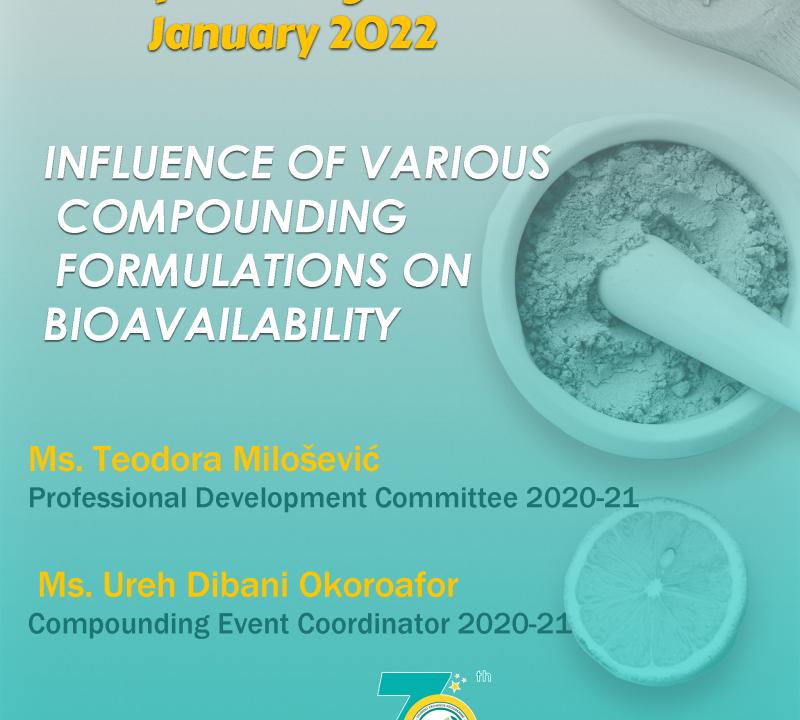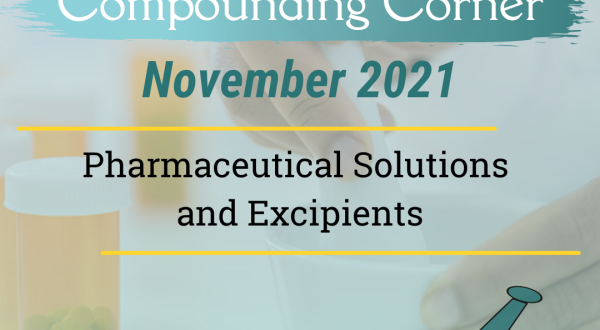
INFLUENCE OF VARIOUS COMPOUNDING FORMULATIONS ON BIOAVAILABILITY
Compounding Corner - January 2022
INFLUENCE OF VARIOUS COMPOUNDING FORMULATIONS ON BIOAVAILABILITY
By
Ms. Teodora Milošević
Professional Development Committee 2020-21
And
Ms. Ureh Dibani Okoroafor
Compounding Event Coordinator 2020-21
image: X7 Research
Drug bioavailability is one of the key factors in drug development, regulatory approval, and clinical drug use. Regulatory requirements for bioavailability were established about 20 years ago as one of the solutions to the many therapeutic failures associated with differences in formulations.
Factors that affect bioavailability can be classified basically into two:
- Factors that affect the dissolution of medicine or release of the active pharmaceutical ingredients (API) from the pharmaceutical preparation: Dissolution or release of the API is considered a prerequisite for the process of drug absorption. Today, one of the main quality control tests conducted on pharmaceutical dosage forms such as tablets and capsules is the dissolution test.
- Excipients-related factors that may affect the stability of the drug at the site of application, drug absorption, or metabolic processes. Particle size, polymorphism, and pH affect bioavailability and thus drug activity. A drug that is insoluble in water and is less available when in the aqueous formulation, would consequently have its activity and bioavailability erratic after oral administration. It has been proven that the bioavailability of drugs is inversely proportional to their particle sizes i.e. the bioavailability increases as the particle size of the drug(s) decrease (s) by appropriate technological procedures.
The term bioavailability refers to the rate and extent to which the active substance is absorbed from the body and becomes available at the site of action unchanged. After oral administration of the drug, in order for the drug to reach the target site of action, it must reach the systemic blood circulation. For drugs intended for systemic absorption, bioavailability from the extravascular site of administration is generally determined by comparing its pharmacokinetic profile in the blood after intravascular administration of the same drug in solution.
In recent years, the number of drugs that are poorly soluble in water and aqueous solutions has been on the rise. Approximately 60–70% of drug molecules are insufficiently soluble in aqueous medium and consequently, their absorption from the gastrointestinal tract (GIT) after oral administration is low. During the stages of drug development, it is necessary to devise adequate strategies to improve the absorption of the drug in order to increase its bioavailability. It is currently considered that different lipid formulations are a good approach to making drug formulations with a high bioavailability profile.
When it is not possible to determine the concentration of a drug in the blood or other relevant biological fluids, other approaches have been developed, such as pharmacodynamic studies and in vitro studies. In some cases, an in-vitro study is being conducted to document bioavailability where an appropriate in-vitro / in-vivo correlation can be established.
After oral administration, the drug must pass through the intestinal wall, then through the portal circulation to the liver. During this transport, the so-called first-pass metabolism takes place (metabolism that occurs before the drug reaches the systemic circulation). Many drugs are metabolized and inactivated before they reach circulation. Low bioavailability is most common with oral dosage forms of poorly water-soluble, slowly absorbed drugs.
One of the causes of low bioavailability is insufficient time for absorption in the gastrointestinal tract. Highly ionized and polar drugs do not dissolve easily and cannot penetrate the epithelial membrane, the time at the site of absorption may be insufficient for their entry into the body. In such cases, bioavailability tends to be very variable as well as low.
Age, gender, physical activity, genetic phenotype, stress, disorders (e.g., malabsorption syndromes), or previous GIT surgery (e.g., bariatric surgery) may also affect drug bioavailability.
Chemical reactions that reduce absorption of drugs may as well reduce their bioavailability. They include complex formation, hydrolysis of gastric acid or digestive enzymes, conjugation in the intestinal wall, adsorption to other drugs, and metabolism by the luminal microflora.
Nowadays the focus is on lipid-based carrier systems. The most popular approach is the incorporation of a poorly water-soluble active substance into inert lipid carriers such as oils, surfactant dispersions, solid dispersions, emulsions, and self-emulsifying formulations.
Lipid formulations for oral administration of drugs are a diverse group of formulations that have a wide range of properties. The main mechanism by which lipid formulations lead to improved bioavailability is usually the avoidance of a slow dissolution process that limits the bioavailability of hydrophobic drugs from solid dosage forms.
Preferably, the formulation allows the drug to remain in a dissolved state during its transit through the GIT. Absorption can be improved by formulating the drug as a solubilizer in a colloidal dispersion. This goal can be achieved by formulating the drug in a self-emulsifying system. Among the different approaches, the self-emulsification drug delivery system has received more attention thanks to increased oral bioavailability that allows for dose reduction, more consistent drug absorption time profiles, and drug protection of adverse intestinal environments.
Different pharmaceutical compounding formulations greatly affect the bioavailability of the active substance.
Parenteral pharmaceutical dosage forms have the highest bioavailability since they are given directly into the systemic circulation, which then distributes the active substance to the site of action.
Oral solutions and powders for oral solutions are much faster and easier to absorb than tablets and capsules. Bioavailability depends on how much of the active substance will be released from the solid pharmaceutical forms. Thus, we can conclude that the disintegration and solubility of oral capsules and tablets are a limiting factor for high bioavailability.
Sublingual tablets have higher bioavailability compared to oral tablets. As sublingual tablets are inserted directly into the systemic circulation through the oral mucosa, they bypass the liver and the metabolism of the first passage, and a higher concentration of the drug will reach the target site of action.
The particle size of oral suspensions and emulsions determines their solubility and absorption. Smaller particles enable easier and faster release of the active substance from the pharmaceutical preparation and consequently better bioavailability.
Reference
Amidon, G. L., Lennernas, H., Shah, V. & Crison, J. (1995) A theoretical basis for a biopharmaceutic drug classification: the correlation of in vitro drug product dissolution and in vivo bioavailability. Pharm. Res.12:413–420 available at: https://pubmed.ncbi.nlm.nih.gov/7617530/
Eddington, N., Marroum, P., Uppoor, R., Hussain, A. & Augsburger, L. (1998) Development and internal validation of an in vitro-in vivo correlation for a hydrophilic metoprolol tartrate extended release tablet formulation. Pharm. Res.15:466–473 available at https://pubmed.ncbi.nlm.nih.gov/9563079/
Polli, J. E. (1998) Dependence of in vitro-in vovo correlation analysis acceptability on model selections. Pharm. Dev. Technol.4:89–96 available at
https://www.tandfonline.com/doi/abs/10.1080/10837459908984228
Kawakami K. Modification of physicochemical characteristics of active pharmaceutical ingredients and application of supersaturatable dosage forms for improving bioavailability of poorly absorbed drugs. Advanced Drug Delivery Reviews. 2012;64(6):480–495. available at https://pubmed.ncbi.nlm.nih.gov/22265844/
Lipinski CA. Drug-like properties and the causes of poor solubility and poor permeability. Journal of Pharmacological and Toxicological Methods. 2000;44(1):235–249 available at https://pubmed.ncbi.nlm.nih.gov/11274893/



